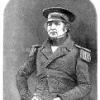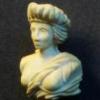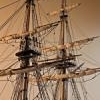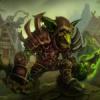-
Posts
1,267 -
Joined
-
Last visited
Reputation Activity
-
 AnobiumPunctatum reacted to mtaylor in Licorne 1755 by mtaylor - 3/16" scale - French Frigate - from Hahn plans - Version 2.0 - TERMINATED
AnobiumPunctatum reacted to mtaylor in Licorne 1755 by mtaylor - 3/16" scale - French Frigate - from Hahn plans - Version 2.0 - TERMINATED
Been a bit since that last update... I stripped off 5 strakes of planking at the stern and reworked it with some help in the form of advice and mentoring from Dan and Druxey. They set me straight and on the right path. I'll do a bit more sanding (still rough only for now) and then turn the hull around and to the other side. I did some templates and the shapes look pretty close so I think that side will go a bit quicker. I shouldn't have to plank, rip off the planks, sand and then replank several times...
I have a dummy fashion piece held in with the blue pin to get the plank ends correct and I'll be fitting the real thing later. I'm not too worried about the plank ends being 100% squared up as there's a reasonably wide covering trim plank that will go over them. Besides, isn't it supposed to be deal with one headache at a time.
I just noticed....my work area is beyond messy... sorry.
Thanks for the comments, the help, and the support. Back to motoring on and making sawdust.
-
 AnobiumPunctatum reacted to rafine in Cutter Cheerful 1806 by rafine - FINISHED
AnobiumPunctatum reacted to rafine in Cutter Cheerful 1806 by rafine - FINISHED
Planking is now underway. I have completed the port side topside planking ( to the point of rough sanding). The caulking is simulated by pencil on one side and end of each plank. Since I've never been able to accurately plank between ports by adding individual planks, I use a method of building up units of planking , which allows me to get perfectly straight edges and correct sizing to obtain the 1/64" rebates around the ports. Where required, the planks are pre-bent to shape before gluing up the unit.
Now it's on to the starboard side to repeat the process.
Bob
-
 AnobiumPunctatum reacted to rafine in Cutter Cheerful 1806 by rafine - FINISHED
AnobiumPunctatum reacted to rafine in Cutter Cheerful 1806 by rafine - FINISHED
Some progress to report. I completed the prep for planking by adding the square tuck stern piece and fillers and then painting the ports. I opened my last ever bottle of Pollyscale ATSF red for the ports.
I then did the first layer of the wales, which was pretty straightforward. Now, it's on to the topside planking.
Bob
-
 AnobiumPunctatum reacted to Cathead in Bertrand by Cathead - FINISHED - 1:87 - wooden Missouri River sternwheeler
AnobiumPunctatum reacted to Cathead in Bertrand by Cathead - FINISHED - 1:87 - wooden Missouri River sternwheeler
After a week of cogitation, I decided to move forward on the hull planking using my best judgement and artistic license. Without absolute proof in any direction, I determined that THIS Bertrand's builders would do best to follow the natural line of the hull, making planking as simple as possible for the basic carpentry skills and simple raw materials available (both in real life and in this budget-constrained model).
I clamped a series of planking strips to the horizontal portion of the hull, to get spacing right, and then extended the fourth one up toward the bow in the most natural curve it would follow (above left). Marking this on the frames with a pencil, I then started cutting planks to length and installing them with wood glue and clamps. Above right, you see five strakes of planking installed. Sorry for the photo quality, this was indoors in evening.
Here's the current bow, next to the best drawing I have from the archaeological documents (the latter flipped to match the photo's orientation). The lie of the planks clearly isn't the same, but I just couldn't figure out how to get the deck-parallel planking shown in the drawing with the geometry of the framing shown in other drawings. Not sure who's wrong; logically my bet's on me rather than the professionals, but who knows. Methods like stealers or aggressive spiling just didn't seem to match the likely approach and skill set of the folks actually building Bertrand, so I went with authentic approach if not result.
I actually like the sweeping curve on the model, at least from an aesthetic point of view. Also, as you'll notice, most of the bow is in fact covered by iron plating to help protect against river debris and snags, so relatively little of this will show anyway. I really appreciate all the folks who chimed in to discuss this question, and I hope my decision turns out acceptably to most viewers. Mrs. Cathead likes it, so there's that.
Finally, notice that on Bertrand, the planks have a scarf joint, not a butt joint. This I'm certain of, because there are photographs of it. So I did my planks the same way, although a bit simplified: Bertrand's planks have a fancy scarf with squared-off tips (look closely at the drawing), which I was not up for recreating at 1:87. So I just cut the angle all the way across and decided it was close enough. This is not, after all, an exquisite world-class museum model, just a farmer's hobby.
Clamping planks on this bow has been an interesting challenge. The guards, which I intentionally installed first in order to help guide planking, are also rather in the way of getting clamps down along the hull. The framing, being so close together, also makes it difficult to get clamps in. From a practical standpoint, I've been very happy with my decision to follow the easiest lie of planking, because the planks fit themselves, don't even need soaking, and require minimal clamping to stay put. This result certainly fits with the theme of building these boats the simplest way.
And here is the hull as of Saturday morning. I filled in the upper bow first, and am slowly working my way down and aft. I haven't done any filling or sanding, so any close-up look appears pretty rough. These planks are quite thin (1/32"), so I intend to do one sanding only when the whole thing is ready, and no more. But to my eyes at least, the pattern is pleasing and approximates authenticity.
Gonna be a busy weekend ahead, here's a fitting tune for this work: "Old Plank Road"
That depends on how the planking goes, but so far so good.
-
 AnobiumPunctatum reacted to Cathead in Bertrand by Cathead - FINISHED - 1:87 - wooden Missouri River sternwheeler
AnobiumPunctatum reacted to Cathead in Bertrand by Cathead - FINISHED - 1:87 - wooden Missouri River sternwheeler
In all fairness, many of us are able to build our models because the reverse is also true, even if husband doesn't rhyme with anything catchy. Happy spouse, happy house?
-
 AnobiumPunctatum reacted to Dan Vadas in HMS Vulture 1776 by Dan Vadas - FINISHED - 1:48 scale - 16-gun Swan-class sloop from TFFM plans
AnobiumPunctatum reacted to Dan Vadas in HMS Vulture 1776 by Dan Vadas - FINISHED - 1:48 scale - 16-gun Swan-class sloop from TFFM plans
Thank you John.
Waist Rails
I have a fair bit more "Iron" work in front of me. The first are the stanchions for the Waist Rails.
The rail itself is timber. It sits inside U shaped brackets atop the stanchions. I cut the brackets from sheet brass using the table saw and soldered them to the wire posts. The uneven thicknesses on the sides of the brackets were filed to size after soldering :
There are also two stanchions that take the entry ropes. I soldered a piece of small tubing to the tops of them to form the eyes that take the ropes :
Danny
-
 AnobiumPunctatum got a reaction from Erebus and Terror in La Créole 1827 by archjofo - Scale 1/48 - French corvette
AnobiumPunctatum got a reaction from Erebus and Terror in La Créole 1827 by archjofo - Scale 1/48 - French corvette
The planking is looking really nice, Johann
-
 AnobiumPunctatum got a reaction from archjofo in La Créole 1827 by archjofo - Scale 1/48 - French corvette
AnobiumPunctatum got a reaction from archjofo in La Créole 1827 by archjofo - Scale 1/48 - French corvette
The planking is looking really nice, Johann
-
 AnobiumPunctatum reacted to archjofo in La Créole 1827 by archjofo - Scale 1/48 - French corvette
AnobiumPunctatum reacted to archjofo in La Créole 1827 by archjofo - Scale 1/48 - French corvette
In the meantime, the planking is completed on the port side.
The hull is not sanded, as can be seen.
-
 AnobiumPunctatum reacted to Mirabell61 in SS Kaiser Wilhelm der Grosse 1897 by Mirabell61 - FINISHED - scale 1:144 - POF - first German four stacker of the Norddeutscher Lloyd line
AnobiumPunctatum reacted to Mirabell61 in SS Kaiser Wilhelm der Grosse 1897 by Mirabell61 - FINISHED - scale 1:144 - POF - first German four stacker of the Norddeutscher Lloyd line
Build log part 11
some progress on building the hull....
Nils
this is no convertion to a viking longboat, but temporary protection to the prolonged bowpost until the upper bow bulwark is ready for attaching
my wife asks me this morning, if I`m sure the ship is not much too narrow...
All the overstanding frame hights have been cut off
between the second and the third rail (stern) I need enough place for attaching the decoration and the name, and homeport.
For providing adequate space for the portholes around the poop and perhaps some "eyebrows" over the portholes, I had to increase the hight of this (round the stern) plank accordingly as well as a good transition of the sheer in foreward direction
these are preliminary deck-stringers, for dry fit. There will be a pit right down to the lower deck, just behind the later forecastle bulwark
-
 AnobiumPunctatum reacted to archjofo in La Créole 1827 by archjofo - Scale 1/48 - French corvette
AnobiumPunctatum reacted to archjofo in La Créole 1827 by archjofo - Scale 1/48 - French corvette
Karl, Mick, Cog and Greg, thanks for looking in.
Slowly but surely, the planking is completed.
I hope that it is the way I imagine it.
-
 AnobiumPunctatum reacted to guraus in HMS Victory by guraus - scale 1:48 - plank on frame
AnobiumPunctatum reacted to guraus in HMS Victory by guraus - scale 1:48 - plank on frame
Another small update the last before a vacation break.
Alexandru
-
 AnobiumPunctatum reacted to Jeronimo in THE 74-GUN SHIP by Jeronimo
AnobiumPunctatum reacted to Jeronimo in THE 74-GUN SHIP by Jeronimo
Hello friends.
Assembly of the deck transom and filling transoms on the fashion piece.
Karl
T e i l 1
-
 AnobiumPunctatum got a reaction from KenW in HM Sloop Fly by AnobiumPunctatum - 1:32 - POF
AnobiumPunctatum got a reaction from KenW in HM Sloop Fly by AnobiumPunctatum - 1:32 - POF
Welcome on bord, Antony
The completion of the hull of my control model in the region behind the last frames has attracted much longer than expected.
When planning the last phase of the construction I realized that the body plan of the original drawing and therefore my reconstruction at the top of the last two frames is too narrow. So back to the drawing board and the frames 19 and 20 newly constructed. The hull at frames 20 is now about 1 mm wider in the region of maximum breath than originally. With the help of several buttok lines and the new water lines I have also redesigned the transoms
I haven't add all changes on the test hull, so you can see in the pictures the not entirely harmonious course of the lines.
The first step of my little project -the reconstruction of the lines- is complete.
In between, I have asked myself several times whether the construction of the half-model was even necessary. After the problems in the reconstruction of the transoms and fashion pieces, that define the shape of the stern, have identified, the construction of the test model was more than worth. I am happy to have the mistakes now and not found during the construction of the POF model.
In the next few weeks I'll construct keel, frames and all other components that are needed to build the hull. In autumn I like to start the construction of the POF model. Until then, one last picture which shows the side view of the test hull.
-
 AnobiumPunctatum got a reaction from Cathead in Bertrand by Cathead - FINISHED - 1:87 - wooden Missouri River sternwheeler
AnobiumPunctatum got a reaction from Cathead in Bertrand by Cathead - FINISHED - 1:87 - wooden Missouri River sternwheeler
The frameing looks really impressive, very nice work
-
 AnobiumPunctatum got a reaction from Eddie in HM Sloop Fly by AnobiumPunctatum - 1:32 - POF
AnobiumPunctatum got a reaction from Eddie in HM Sloop Fly by AnobiumPunctatum - 1:32 - POF
The transoms can not be derived directly from my reconstruction of the body plan.In the half breath plan of the orioginal drawing the form of each timber is indeed located, but does not fit properly on the corrected design. Before starting for the next step I have taken these lines and adjust them so that they match up with my design and also with the position of transoms in Sheer plan.
Subsequently the transoms were transferred to 3mm plywood, sawn and glued on the control model. I 've filles the gaps as usual with poplar plywood. After sanding the area looks like in the following pictures:
-
 AnobiumPunctatum got a reaction from Eddie in HM Sloop Fly by AnobiumPunctatum - 1:32 - POF
AnobiumPunctatum got a reaction from Eddie in HM Sloop Fly by AnobiumPunctatum - 1:32 - POF
Thanks Johann, druxey, Mike and Nils for your nice comments and all others for the Likes
Next I've installed all bulkheads until frame 20 and the filling pieces.
Then my favourite pastime - sanding
-
 AnobiumPunctatum got a reaction from Eddie in HM Sloop Fly by AnobiumPunctatum - 1:32 - POF
AnobiumPunctatum got a reaction from Eddie in HM Sloop Fly by AnobiumPunctatum - 1:32 - POF
With the build of my control model I started at the end of March.
The edges of all frames I've colored black. This will be later a great help by sandig the hull.
The glued surface of the cant frames is very small, so I've glued first plywood stripes on the center board.
To get the correct alignment the colored 5' marks on the frames and the center board are a great help.
First half of frame 0
Six frames have been installed.
At this time I've started to glue the filling pieces of polar plywood between the frames. I've used a chess board pattern to avoid the distortion of the frames.
Until the mid of April I've installed all frames and filling pieces from the center to the stem on the stem.
The next two pictures show the result of the work. It's looking very horrible
-
 AnobiumPunctatum got a reaction from Eddie in HM Sloop Fly by AnobiumPunctatum - 1:32 - POF
AnobiumPunctatum got a reaction from Eddie in HM Sloop Fly by AnobiumPunctatum - 1:32 - POF
Then I've started sanding the hull. I've used 60 grid until 120 grid sandpaper for the process. After around one week - I can only work on my model in the evening or at the weekends- I've finished the front half of my control model.
I am very happy with the result
To check the curves I use 1mm thick stripes of maple. The found differences are very small. So I think that my reconstruction will work for the checked range.
-
 AnobiumPunctatum reacted to Cathead in Bertrand by Cathead - FINISHED - 1:87 - wooden Missouri River sternwheeler
AnobiumPunctatum reacted to Cathead in Bertrand by Cathead - FINISHED - 1:87 - wooden Missouri River sternwheeler
Mark, thanks for the input and hope I'm not seeming argumentative. I'm going to keep thinking it over. The obsessive part of me is actually considering building a false bow with similar configuration to test out how each approach would actually look. In the meantime, I can let it simmer while I work on the decking.
Speaking of which, here's another update after the weekend's work:
While I think about planking, I've worked on filling in structure. The deck was mildly cambered, with deck beams resting on one longitudinal bulkhead running along the keelson. So the first step was to figure out how high I wanted this bulkhead (and thus the camber), and how to keep it fairly consistent along the run of the hull, rising with the sheer of the stem and stern from the flat central portion of the hull. I wanted the camber to last all the way to the stern, but naturally peter out into a smooth surface at the stempost. This appears to be accurate based on my sources.
I accomplished this the way I do many projects, by careful dead reckoning. I figured out the proper bulkhead height at the center of the hull, by test-fitting various stanchion lengths with deck beams resting on top until I got something that looked right. Then I cut a stringer the length of the hull, to act as the top of the bulkhead, and began gluing it onto stanchions of equal height along the flat center portion of the hull, letting both ends float free. Once that was dry, I began carefully cutting individual stanchions to increasing lengths, inserting them under the stringer one by one while test-fitting deck beams to ensure a smooth curve. The photos above show the stern end completed; if you look carefully down the hull, you can see the bow end still floating free. Then I did the same for the bow. This center bulkhead was finished with planking on the real Bertrand, dividing the hull into separate halves, but I'm omitting that for viewing clarity.
At some point I decided I was getting tired of having the hull loose on my work bench, so spot-glued a thick beam to the bottom of the hull, where my clamp can get a good grip. Big improvement; I can now swivel the hull to any orientation I need.
With the longitudinal bulkhead properly finished, and all support stanchions glued in, I began attaching deck beams, a repetitive but fairly easy process. Below is the final result, after a lot of sanding to produce smooth curves all the way around. Interestingly, the guards (which I intended to be level) ended up a bit gull-winged in places, angling inward slightly toward the deck camber. This annoyed me, until I happened to read in one of my sources that some period boats actually did have inward-sloping guards, though it's believed Bertrand didn't. It's barely noticeable, and at least it's authentic to the period if not the exact prototype.
After I was happy with the deck beams, I moved on to preparing a few more details. I framed in the five hatches (one at left stern, and two pairs centered about 40' from the stern and just aft of the bow). I intend to leave all these open.
I have now reached the point that I have to make a decision on how to finish the model, no more waffling. I am sticking with my original goal, despite various forays into conjecture, of finishing the port side completely, and leaving the starboard side as open-framed as possible to allow views of the internal structure. I want to be able to photograph the model from certain angles and have it look realistically complete, but have in-person viewers be able to turn it around and look inside. Thus I will have to add much, but not all, of the decking (I may use piles of cargo to hide missing decking for photography in some places).
With this in mind, I added one more set of details. The deck beams and guards, as installed so far, are actually half as numerous as on the real boat. I decided to leave the deck beams as-is to facilitate interior views, but to fill in the guard supports on the starboard side for more realism. This accounts for the different you may already have noticed, but which is very clear in this overhead photo. Looking closely, you can also see the framed-in deck hatches, and the doubled-up deck beams which support the boiler, about 1/3 of the length from the bow.
The boat is nearly read for some decking, and is ready for planking on the port side once I decide how I want to do it. In the meantime, here's Alison Krauss & Union Station with the feelings of all Missouri after the last two months: "Rain, Please Go Away"!
-
 AnobiumPunctatum reacted to tlevine in HMS Atalanta 1775 by tlevine - FINISHED - 1:48 scale - from TFFM plans
AnobiumPunctatum reacted to tlevine in HMS Atalanta 1775 by tlevine - FINISHED - 1:48 scale - from TFFM plans
Time to work on the pumps and cistern. I had previously rough-shaped the hexagonal pump tubes and left them long for final shaping later. There are four tubes that terminate in the cistern and in front of them are the two hand pumps. Each of the tubes was cut to length based on the drawings in TFFM. They were bored for insertion of the pistons later. They have been dry-fit into their openings in the deck and main mast partners. The nozzles for the hand pumps point 45o aft. I did not have any metal supplies with me this week so they will be finished and permanently installed later.
The cisterns are relatively straightforward. They are essentially boxes with two vertical side and two canted sides sitting on legs which are wider in the front than in the back. There is a slot outboard for insertion of the pump dale and holes in the bottom for the pump tubes. The outboard feet are taller than the inboard ones to compensate for the thickness of the mast partner.
There is a removable cowling which covers the pump wheel and chain assembly. I have decided to make the port cowling and leave the starboard cistern uncovered to demonstrate the wheel and chain. They still need to be detailed and I have not decided whether to show the pump dale. Where would it be stored when not in use?
The cisterns are temporarily set in place behind the main mast. There are a lot of structures in a very small space.
-
 AnobiumPunctatum reacted to Mirabell61 in SS Kaiser Wilhelm der Grosse 1897 by Mirabell61 - FINISHED - scale 1:144 - POF - first German four stacker of the Norddeutscher Lloyd line
AnobiumPunctatum reacted to Mirabell61 in SS Kaiser Wilhelm der Grosse 1897 by Mirabell61 - FINISHED - scale 1:144 - POF - first German four stacker of the Norddeutscher Lloyd line
Many thanks Patrick and Mick,
and all the "like this" button activators...
Patrick,
Thanks for your appreciation, I took her off the board this afternoon and was delighted of the work so far, a straight symetric and light hull like it should be. All the overstanding frame hights will be removed (cut off) and the upper deck stringers put on. The slot places are integrated alrteady when I cut the frames
I am including some pics of this milestone moment....
Mick,
Thanks for your words ,..
For plating I shall use self-adhesive aluminium foil stripes which will be ponced from the rear side to resemble the riveting
Before the plating comes on, there is still some filler application work to be done, and several semi-round rails must be attached to the ouside hull skin.
removed from the board and put on the upper end-cap plank 180° around the stern.
Stb aft view...
stb front view
view into the aft ship hull. The outcuts for the deck stringers can be seen here
the "deck-beam" upper lnes are pre cut, so only the outer sides of the frames need to be cut. In this way the decks will have a positive curvature in width direction
one of the three lock-nut devices for the stand`s pedestal-spindles (through the keel and anchored in the "backbone" )
removing some old hardened glue drops out of the hull
-
 AnobiumPunctatum got a reaction from Mirabell61 in SS Kaiser Wilhelm der Grosse 1897 by Mirabell61 - FINISHED - scale 1:144 - POF - first German four stacker of the Norddeutscher Lloyd line
AnobiumPunctatum got a reaction from Mirabell61 in SS Kaiser Wilhelm der Grosse 1897 by Mirabell61 - FINISHED - scale 1:144 - POF - first German four stacker of the Norddeutscher Lloyd line
Really nice hull, Nils
-
 AnobiumPunctatum reacted to Dan Vadas in HMS Vulture 1776 by Dan Vadas - FINISHED - 1:48 scale - 16-gun Swan-class sloop from TFFM plans
AnobiumPunctatum reacted to Dan Vadas in HMS Vulture 1776 by Dan Vadas - FINISHED - 1:48 scale - 16-gun Swan-class sloop from TFFM plans
Fish Davit
The Fish Davit is used when pulling up the Anchor. The associated tackle literally is used to "fish" the anchor around the flukes and then haul the crown end up ready for stowing.
The davit is tapered by 3 scale inches on all four sides. A stop is cut into each end :
A handrope is fitted to enable the davit to be manhandled into position. Nine eyestrops hold the two ropes together by passing through the centre of the davit. These were a whole lot of fun to fit, as they have an eye in one end and the other end doubles back into the hole. A drop of PVA glue holds the doubled end in place :
Danny
-
 AnobiumPunctatum got a reaction from Eddie in HM Sloop Fly by AnobiumPunctatum - 1:32 - POF
AnobiumPunctatum got a reaction from Eddie in HM Sloop Fly by AnobiumPunctatum - 1:32 - POF
Welcome on bord, Antony
The completion of the hull of my control model in the region behind the last frames has attracted much longer than expected.
When planning the last phase of the construction I realized that the body plan of the original drawing and therefore my reconstruction at the top of the last two frames is too narrow. So back to the drawing board and the frames 19 and 20 newly constructed. The hull at frames 20 is now about 1 mm wider in the region of maximum breath than originally. With the help of several buttok lines and the new water lines I have also redesigned the transoms
I haven't add all changes on the test hull, so you can see in the pictures the not entirely harmonious course of the lines.
The first step of my little project -the reconstruction of the lines- is complete.
In between, I have asked myself several times whether the construction of the half-model was even necessary. After the problems in the reconstruction of the transoms and fashion pieces, that define the shape of the stern, have identified, the construction of the test model was more than worth. I am happy to have the mistakes now and not found during the construction of the POF model.
In the next few weeks I'll construct keel, frames and all other components that are needed to build the hull. In autumn I like to start the construction of the POF model. Until then, one last picture which shows the side view of the test hull.








